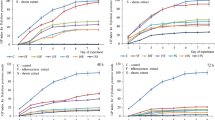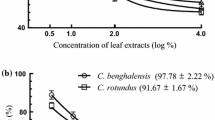Abstract
In some parts of Karnataka and Maharashtra states (India), a leguminous undershrub, Cassia uniflora has effectively replaced the problematic weed Parthenium hysterophorus (parthenium). The studies revealed that the phenolic leachates from different parts of C. uniflora, specially from germinating seeds significantly inhibited the germination of parthenium seeds and retarded the growth of seedlings from the successfully germinated parthenium seeds. At field level, seedlings of C. uniflora outcompeted the seedlings of summer generation of parthenium causing reduction in height, dry weight and number of inflorescences of the latter which ultimately resulted in reduction of their seed output. Because of its longer life span, C. uniflora effectively prevented the establishment of parthenium plants of the winter generation in its area of growth. Results indicate that C. uniflora replaces parthenium through interference.
Similar content being viewed by others
References
Desai S N and Bhoi P G 1981 Comparative competitive response of Parthenium hysterophorus and Stylosanthes hamata in the control of parthenium. J. Mah. Agric. Univ. 6, 266–267.
Dube V P, Singal V P and Tyagi S 1979 Parthenium hysterophorus: Allelopathic effects on vegetable crops. Bot. Prog. 2, 62–69.
Gidwani I 1975 Weed out ‘Congress grass’ or else face disaster Current Oct 25, pp 12, 13 and 17
Gant R E and Clebsch E E C 1975 The allelopathic influences of Sasunfras albidum in old-field succession in Tennessee. Ecology 56, 604–615.
Heisey R M and Delwische C C 1985 Allelopathic effects of Trichostema lanceolatum (Labiatae) in the California annual grassland. J. Ecol. 73, 729–742.
Jayakumar R 1985 Studies on the Effect of Cassia sericea Sw on Seed Germination and Seedling Vigour of Parthenium hysterophorus L. M.Sc. Thesis, Univ. of Agric. Sciences, Bangalore, India.
Jayanth K P 1987 Introduction and establishment of Zygogramma bicolorata on Parthenium hysterophorus at Bangalore, India. Curr. Sci. 56, 310–311.
Johansen D A 1940 Plant Microtechnique. McGraw-Hill Book Co. Inc., New York. 523 p.
Joshi S and Mahadevappa M 1984 Cassia sericea Sw-new record for Belgaum, Dharwad and Bellary districts. Curr. Res. 13, 32.
Joshi S and Mahadevappa M 1986 Cassia sericea Sw. to fight Parthenium hysterophorus L. Curr. Sci. 55, 261–262.
Krishnamurthy K, Ramachandraprasad T V, Muniyappa T V and Venkata Rao B V 1977 Parthenium, a new pernicious weed in India. UAS Technical Series 17 Bangalore, India. 66 p.
Lakshmi Rajan 1973 Growth inhibitors from Parthenium hysterophorus L. Curr. Sci. 20, 729–730.
Mall L P and Dagar J C 1979 Effect of Parthenium hysterophorus extract on the germination and early seedling growth of three crops. J. Indian Bot. Soc. 58, 40–43.
McPherson J K and Muller C H 1969 Allelopathic effects of Adenostoma fasciculatum ‘chamise’, in the California chapparal. Ecol. Monogr. 39, 177–198.
Muller C H 1966 The role of chemical inhibition (allelopathy) in vegetation composition. Bull. Torrey Bot. Club 93, 322–351.
Raghavan B S 1980 Cassia uniflora Mill (Caesalpiniaceac)—a new record for India. Bull. Bot. Surv. India 22, 225.
Rice E L 1984 Allelopathy. Academic Press Inc., New York. 422 p.
Singh N P 1979 Cassia sericea Sw—a new record for India. Bull. Bot. Surv. India 21, 203–205.
Singh N P 1983 Potential biological control of Parthenium hysterophorus L. Curr. Sci. 52, 644.
Stowe L G 1979 Allelopathy and its influence on the distribution of plants in an Illinois old-field. J. Ecol. 67, 1065–1085.
Sukhada D K 1975 Growth inhibitors from Parthenium hysterophorus Linn. Curr. Sci. 44, 358–359.
Sukhada D K and Jayachandra 1977 Parthenium weed menace in India and its control. Proc of the All India Weed Science Conference held at Hyderabad from 17–22 January.
Sundara Rajulu and Gowri 1976 Biological control of the poisonous weed parthenium. UAS Technical Series 16, 23–31.
Towers G H N, Mitchell J C, Rodriguez E, Bennett F D and Subba Rao P V 1977 Biology and chemistry of Parthenium hysterophorus L.—a problem weed in India. J. Scient. Ind. Res. 36, 672–684.
Tukey H BJr. 1969 Implications of allelopathy in agricultural plant Science. Bot. Rev. 35, 1–16.
Vartak V D 1968 Weed that threatens crop and grasslands in Maharashtra, Indian Fmg. 18, 23–24.
Author information
Authors and Affiliations
Rights and permissions
About this article
Cite this article
Joshi, S. Interference effects of Cassia uniflora Mill on Parthenium hysterophorus L.. Plant Soil 132, 213–218 (1991). https://doi.org/10.1007/BF00010402
Received:
Issue Date:
DOI: https://doi.org/10.1007/BF00010402




